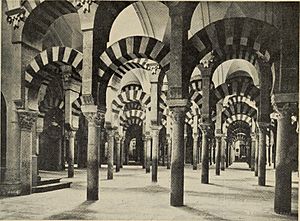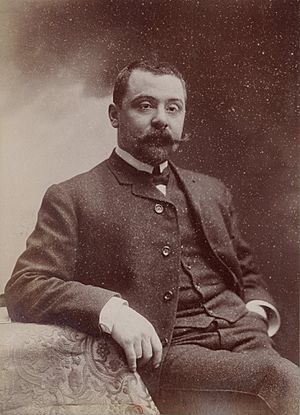Élie Faure facts for kids
Élie Faure (born April 4, 1873, in Sainte-Foy-la-Grande, France; died October 29, 1937, in Paris) was a French doctor, art historian (someone who studies the history of art), and essayist (a writer of essays). He is famous for his book History of Art, which is a very important work in the field of art history.
Contents
Élie Faure's Life Story
Early Life and Education
Élie Faure was born to Pierre Faure, a merchant, and Zéline Reclus. He was very close to his uncles, Élisée Reclus, who was a geographer and an anarchist activist (someone who believes in a society without government), and Élie Reclus, an ethnologist (someone who studies different cultures).
In 1888, Élie moved to Paris with his brothers, Léonce and Jean-Louis. He studied at the Lycée Henri-IV high school. There, he had famous classmates like Léon Blum, who later became a prime minister.
Élie loved painting and often visited the Louvre museum. He also deeply studied the ideas of his philosophy teacher, Henri Bergson.
After finishing high school, he went to medical school. He worked as a doctor in working-class areas of Paris. He became an anesthesiologist (a doctor who gives medicine to stop pain during surgery) and specialized in embalming (preserving bodies) with his brother Jean-Louis, who was a surgeon. Even while working as a doctor, he continued to visit art exhibitions and artists' studios.
In 1896, Élie Faure married Suzanne Gilard. They had a daughter named Elisabeth. In 1899, he completed his medical degree with a special study on a new treatment for lupus.
He also got involved in politics, supporting Dreyfus during a famous legal case. He also joined socialist groups, which believed in a fairer society.
Becoming an Art Historian
In 1902, Élie Faure started writing articles for L'Aurore, a newspaper in Paris. He wrote about art shows called Salons. These were big events where artists showed their new works.
Through his writing, he met many important artists like Eugène Carrière, Antoine Bourdelle, and Auguste Rodin. He was especially interested in the painters Paul Cézanne and Diego Vélasquez. He wrote his first book about Vélasquez.
From 1905 to 1909, Élie Faure gave talks about art history at a university in Paris. These talks became the basis for his most famous work, History of Art. This huge book, first published in 1909, explored the history of architecture, sculpture, painting, and home arts from ancient times to the early 1900s.
In 1904, he joined the committee of the Salon d'Automne, another important art exhibition. He helped organize several shows there. In his book Les Constructeurs (1914), he thought about the role of artists in society. He also explored the ideas of thinkers like Michelet and Nietzsche.
Experiences in World War I
During the First World War, Élie Faure served as a military doctor on the front lines. The intense fighting deeply affected him. He was later moved away from the battlefield and diagnosed with neurasthenia, a type of nervous exhaustion.
He returned to the front as a doctor during the Battle of the Somme. In his book The Holy Face (1918), he wrote about his thoughts and feelings during the war. The book describes his time as a frontline doctor and his recovery period. It also includes his experiences in the Somme.
After the War and Travels
After the war, Élie Faure continued to write and travel a lot. He became interested in movies, philosophy, and history. He even wrote a biography of Napoleon in 1921.
In 1931, he traveled around the world. He met the painter Diego Rivera in Mexico. He also visited the United States, Japan, China, India, and Egypt.
In the 1930s, Élie Faure became worried about the rise of fascism (a political system where a strong leader and government control everything). He joined a group called the "committee of anti-fascist intellectuals" after protests in Paris in 1934. He supported the Republicans against Franco during the Spanish Civil War. He visited fighters in Barcelona and Madrid.
In 1936, he became a co-chairman of the Committee for Aid to the Spanish People. He continued to speak out for Spain until his death. His writings about the war in Spain were published after he died in a book called Meditations catastrophiques.
Élie Faure died of a heart attack in Paris on October 29, 1937. He was buried in his family cemetery in Saint-Antoine-de-Breuilh.
Special Friendship
Élie Faure greatly admired the painter Chaïm Soutine, believing he was a genius. From 1927, Faure helped Soutine by taking him on trips, paying some of his debts, and buying his paintings. He also wrote a book about Soutine in 1929.
Their close friendship eventually faced difficulties. Soutine fell in love with Faure's daughter, Marie-Line. Even after their friendship became strained in 1930, Faure wrote to Soutine, saying, "You were, you still are, apart from my two sons, the only man I love."

Élie Faure's Books
- Vélasquez (1903)
- Formes et Forces (1907)
- Eugène Carrière (1908)
- Les Constructeurs (1914)
- La Conquête (1917)
- La Sainte Face (1917)
- La Roue (1919)
- La Danse sur le Feu et l'Eau (1920)
- Napoléon (1921)
- Histoire de l'Art (1919–1921)
- L'Arbre d'Éden (1922)
- Cervantes (1926)
- L'Esprit des Formes (1927)
- Découverte de l'Archipel (1932)
- D'Autres Terres en Vue (1932)
- Mon Périple Suivi de Reflets dans le Sillage (1931)
- Équivalences (1951)
- Fonction du Cinéma: De la Cinéplastique à son Destin Social, 1921–1937 (1953)
- Méditations Catastrophiques (2006)
Interesting Facts
- In the movie Pierrot le Fou (1965) by Jean-Luc Godard, a character played by Jean-Paul Belmondo is seen reading Élie Faure's Histoire de l'art.
- The American writer Henry Miller mentions Élie Faure's works in his novels like Tropic of Capricorn (novel).
- Will Durant, a famous historian, included Faure's 4-volume History of Art on his list of "100 Best Books for an Education."
See also
 In Spanish: Élie Faure para niños
In Spanish: Élie Faure para niños


